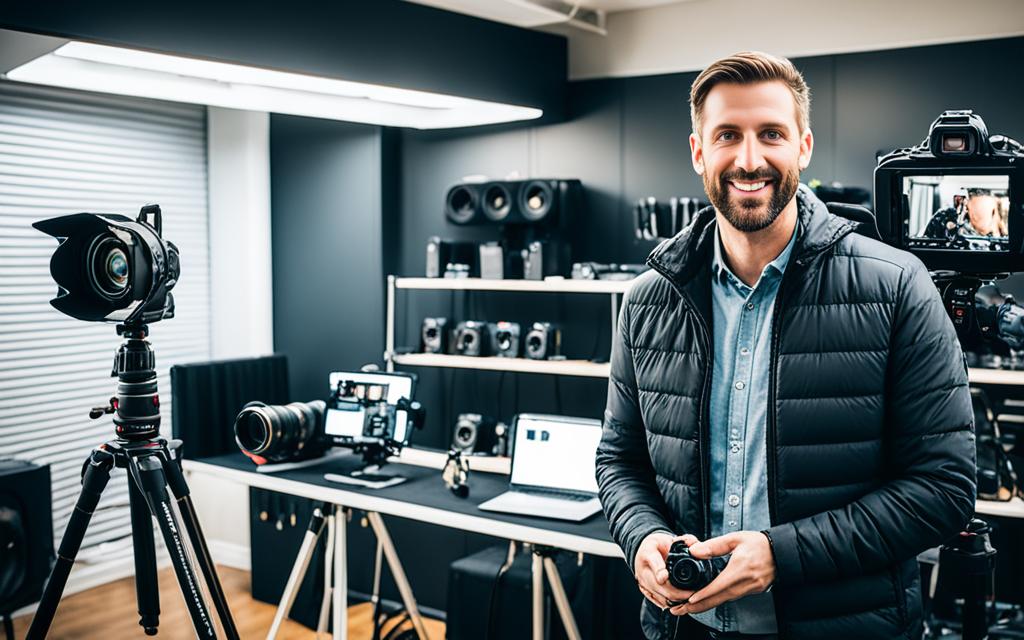Welcome to the Script to Screen Guide, your ultimate resource for mastering the art of video content creation. Whether you’re a seasoned filmmaker or a beginner looking to dive into the world of video production, this comprehensive guide will take you through every step of the process, from the initial script idea to the final polished video.
Creating compelling video content requires careful planning, creative storytelling, and technical expertise. With this guide, we aim to provide you with all the essential knowledge and tips you need to bring your vision to life. From writing an effective script to mastering shooting techniques and post-production editing, we’ve got you covered.
Throughout this guide, we’ll explore the key elements of video production, offering practical advice, expert insights, and real-world examples. Whether you’re creating videos for marketing purposes, educational content, or entertainment, our goal is to help you produce high-quality videos that captivate your audience.
Ready to embark on this exciting journey? Let’s dive right in and discover how to bring your ideas from script to screen. Whether you’re a solo creator, part of a team, or an aspiring filmmaker, this guide will equip you with the fundamentals and strategies to create professional-looking videos that engage, inform, and entertain.
So, grab your camera, unleash your creativity, and let’s get started on this comprehensive video content creation journey!
Writing an Effective Script
When it comes to creating video content, a well-crafted script is the foundation for success. Writing an effective script not only ensures that your message resonates with your audience, but it also helps you stay organized and focused during production.
To create a script that engages viewers and captures their attention, consider the following key elements:
- Define your objective: Start by clearly defining the objective of your video. What do you want to achieve? Is it to educate, entertain, or inspire? By understanding your goal, you can tailor your script to effectively communicate your message.
- Know your audience: Research and understand your target audience. What are their interests, needs, and pain points? By knowing your audience, you can create a script that speaks directly to them, making your content more relatable and engaging.
- Develop a compelling narrative: Craft a compelling story that grabs the attention of your viewers from the very beginning. Use techniques such as suspense, humor, or emotion to captivate your audience and keep them engaged throughout.
- Create a logical structure: Organize your script in a logical manner that flows smoothly from one idea to the next. Use clear and concise language to convey your message effectively, avoiding unnecessary jargon or complex terminology.
- Keep it concise: Remember, brevity is key. In the age of short attention spans, keeping your script concise and to the point is essential. Trim any unnecessary information or dialogue to ensure your video delivers maximum impact.
Effective scripts leave room for improvisation, allowing actors and presenters to add their unique touch while staying true to the core message.
Remember to keep the tone and style of your script aligned with your brand. Whether you aim for a casual and conversational approach or a more formal tone, consistency is key throughout your video.
By following these key elements in scriptwriting, you can create videos that capture your audience’s attention and deliver your message effectively. A well-crafted script sets the stage for a successful production and ensures that your video leaves a lasting impact.
Planning Your Shoot
When it comes to creating a successful video, proper planning is key. The pre-production phase sets the foundation for a smooth and efficient shoot. By taking the time to plan your shoot, you can ensure that everything runs seamlessly and that you capture the footage you need.
One of the first steps in planning your shoot is location scouting. Whether you’re shooting indoors or outdoors, finding the right location can greatly enhance the overall look and feel of your video. Consider the visual aesthetic, lighting conditions, and any required permits or permissions for filming in specific areas.
Creating a detailed schedule is another crucial aspect of planning your shoot. Break down the shoot day by day or even hour by hour, outlining the specific scenes or shots you need to capture. This will help you stay organized and ensure that you make the most of your shooting time.
Don’t forget about equipment preparation. Make a checklist of all the gear you’ll need for the shoot, including cameras, lenses, microphones, and lighting equipment. Prepare backups and test everything ahead of time to avoid any technical issues during the shoot.
Consider creating a shot list or storyboard to visually map out your shots. This will help you communicate your vision to your team and ensure that you capture all the necessary footage. Break down each scene into individual shots, specifying camera angles, movements, and any additional elements required.
Lastly, don’t underestimate the importance of communication and collaboration with your team. Clearly communicate your expectations, roles, and responsibilities to ensure everyone is on the same page. Regularly check in with your team members and address any questions or concerns that may arise.
Proper planning ensures that your video shoot goes smoothly, maximizing efficiency and minimizing potential issues. Take the time to scout locations, create a schedule, prepare your equipment, and communicate effectively with your team. By planning ahead, you’ll set yourself up for success and produce high-quality video content.
Tips for Planning Your Shoot:
- Research potential locations and consider their suitability for your video
- Create a detailed shooting schedule, breaking down each scene or shot
- Prepare all necessary equipment and test it before the shoot
- Develop a shot list or storyboard to visualize your shots
- Communicate clearly with your team and address any concerns
| Planning Checklist | Location Scouting | Schedule |
|---|---|---|
| Camera | Scenic outdoor locations | Shoot day breakdown |
| Lenses | Indoor spaces with appropriate lighting | Specific scene timings |
| Microphones | Permits or permissions required | Shot duration |
| Lighting equipment | Accessibility and logistics | Camera movements |
Key Elements of Pre-Production
Pre-production is a crucial phase in the video content creation process. It sets the foundation for a successful production by ensuring that every aspect is meticulously planned and organized. In this section, we will explore the key elements of pre-production that contribute to a seamless and efficient video shoot.
Storyboarding
Storyboarding is an essential step in visualizing your video before filming begins. By creating a sequence of illustrated panels, you can outline each shot, frame by frame, providing a visual representation of your script. This process allows you to identify any potential issues or gaps in the story and make necessary adjustments before production begins. A well-executed storyboard ensures that you capture all the necessary shots and maintain visual consistency throughout your video.
Casting
The casting process involves selecting the right actors or talent to bring your script to life. It is crucial to choose individuals who align with the vision and tone of your video. Conduct auditions or review showreels to assess their acting skills and suitability for the roles. Selecting the perfect cast enhances the overall quality and impact of your video, making it more engaging for your audience.
Production Design
Production design encompasses everything that appears on camera, including set design, props, costumes, and makeup. It plays a significant role in creating the desired atmosphere and enhancing the story. Whether you’re aiming for a realistic or stylized look, paying attention to production design details adds depth and authenticity to your video.
Creating a Detailed Production Plan
A comprehensive production plan helps streamline the entire video shoot. It includes elements such as scheduling, location scouting, equipment requirements, and budgeting. A well-organized production plan ensures that you have all the necessary resources and information to execute your video project efficiently, minimizing any potential delays or issues.
By focusing on these key elements of pre-production, you set the stage for a successful video shoot. Taking the time to storyboard, choose the right cast, design the production elements, and create a detailed production plan ensures that your video production runs smoothly from start to finish.
| Key Elements | Importance |
|---|---|
| Storyboarding | Visualize the video and make necessary adjustments before production. |
| Casting | Select the perfect actors to bring the script to life. |
| Production Design | Create a visually appealing and authentic atmosphere on camera. |
| Production Plan | Organize resources and information to ensure an efficient video shoot. |
Shooting Techniques for Quality Footage
When it comes to creating compelling videos, shooting techniques play a crucial role in capturing high-quality footage that engages your audience. From camera angles to lighting, composition, and sound recording, each element contributes to the overall impact of your video content. By mastering these techniques, you can elevate the visual aesthetic and storytelling of your videos. Here are some essential shooting techniques to consider:
1. Camera Angles
The angle at which you position your camera can drastically impact the mood and perspective of your video. Experiment with different angles such as low-angle shots for a dramatic effect or high-angle shots to evoke a sense of vulnerability. Adding variety to your camera angles can make your videos visually dynamic and engaging.
2. Lighting
Proper lighting can enhance the overall look and feel of your footage. Natural light is ideal whenever possible, but you can also use artificial lighting to create the desired atmosphere. Experiment with different lighting setups and techniques, such as three-point lighting, to achieve a professional and visually appealing result.
3. Composition
The composition of your shots can greatly influence the visual appeal and storytelling of your videos. Follow the rule of thirds, which involves dividing the frame into a grid and placing points of interest along the intersecting lines. This technique helps create a balanced and visually pleasing composition.
4. Sound Recording
Quality audio is just as important as the visuals in your video. Pay attention to the sound recording process, ensuring clear and crisp audio. Use external microphones or lavalier mics to capture high-quality sound and minimize background noise.
By incorporating these shooting techniques into your video production process, you can elevate the quality of your footage and create captivating videos that leave a lasting impression on your audience.
Post-Production Editing Tips
Once you have completed the shooting phase of your video production, it’s time to move on to the post-production process. This is where you bring all the pieces together and transform raw footage into a polished final product. In this section, we will explore some essential tips and techniques for effective post-production editing.
Choosing the Right Video Editing Software
Before diving into the editing process, it’s crucial to select the right video editing software that suits your needs. Popular options include Adobe Premiere Pro, Final Cut Pro, and DaVinci Resolve. These tools provide a wide range of features and capabilities to help you achieve professional-looking results.
Basic Editing Techniques
As you start editing your video, keep in mind some fundamental techniques to enhance the overall quality. Begin by organizing your footage into a logical sequence and removing any unwanted clips. Trim and cut the footage to create a cohesive narrative flow. Use transitions to smooth out the jumps between scenes, and add text overlays or captions to provide context or emphasize important information.
Adding Transitions and Effects
Transitions and effects can add visual interest and enhance the overall viewing experience. Experiment with different transition options, such as fades, dissolves, or wipes, to create smooth and seamless scene changes. Additionally, consider incorporating visual effects like color grading or filters to evoke specific moods or atmospheres.
Enhancing Audio Quality
Audio is an often overlooked but crucial aspect of post-production. Poor audio quality can detract from the viewing experience. Use audio editing tools to eliminate background noise, adjust volume levels, and synchronize audio with video. Adding a background music track can also enhance the emotional impact of your video.
To further enhance your post-production editing skills, consider investing time in learning advanced techniques like color correction, motion graphics, and keyframing. These skills can take your videos to the next level and help you stand out from the competition.
| Editing Tips | Description |
|---|---|
| Stay Organized | Keep your project files organized to easily locate and access your footage and assets. |
| Use Keyboard Shortcuts | Familiarize yourself with keyboard shortcuts to speed up your editing workflow. |
| Experiment with Effects | Don’t be afraid to try out different effects and transitions to add creativity to your video. |
| Seek Feedback | Share your work with others and gather constructive feedback to improve your editing skills. |
| Test Export Settings | Before finalizing your video, test different export settings to ensure optimal video quality and file size. |
| Backup Your Files | Regularly back up your project files to prevent data loss and protect your hard work. |
Finalizing and Publishing Your Video
Once you’ve completed the post-production editing process, it’s time to finalize your video and prepare it for publishing. This crucial stage involves adding the finishing touches to your video, optimizing it for different platforms, and selecting the right channels to share your content with your target audience.
Color Grading and Graphics
To enhance the visual appeal of your video, consider adding color grading and graphics. Color grading helps create a consistent and professional look by adjusting colors, tones, and contrast. It can evoke different moods and emotions, adding depth and dimension to your footage.
Graphics and titles are another important aspect of finalizing your video. They help convey information, provide context, and visually engage viewers. Use graphics sparingly and ensure they complement your content without overwhelming it.
Optimizing Video Formats
Before publishing your video, it’s essential to optimize it for different platforms and devices. Each platform may have specific requirements for video formats, resolutions, and file sizes. By optimizing your video, you ensure that it loads quickly, plays smoothly, and maintains its quality across various devices and platforms.
Consider using video compression techniques to reduce file sizes without compromising quality. This will help improve loading times and provide a better user experience for your viewers.
Selecting the Right Publishing Platforms
Choosing the right publishing platforms for your video is crucial for reaching your target audience effectively. Consider your audience demographics and preferences when selecting platforms such as YouTube, Vimeo, Facebook, or Instagram. Each platform has its strengths and features that can help you maximize your video’s reach.
Additionally, you can embed your video on your website or blog, share it via email newsletters, or leverage other social media platforms to expand its visibility. Prioritize platforms that align with your target audience’s interests and behavior.
With your video finalized and optimized, it’s time to spread the word. Share your video across your selected platforms and use effective marketing strategies to promote it. Stay tuned for the next section, where we dive into valuable techniques for marketing your video content.
Marketing Your Video Content
Once you have created a compelling video, it’s time to promote and market it to reach your intended audience. Implementing effective marketing strategies is crucial to maximize the visibility and engagement of your video content. Here are some key tactics to consider:
Social Media Promotion
Social media platforms such as Facebook, Instagram, Twitter, and YouTube are powerful tools for promoting your video content. Create engaging posts, use eye-catching thumbnails, and include relevant hashtags to increase your content’s discoverability. Encourage your audience to share and engage with your video to extend its reach organically.
Influencer Collaborations
Partnering with influencers in your industry can significantly boost your video’s exposure. Identify influencers whose audience aligns with your target demographic and reach out to collaborate on video content. Their endorsement and distribution can help you reach a wider audience and build credibility within your niche.
Search Engine Optimization (SEO)
Optimizing your video for search engines is essential for increasing its visibility in search results. Use relevant keywords in your video title, description, and tags to improve its ranking. Embedding your video on your website and optimizing your website’s metadata can also contribute to higher search rankings.
Implementing a comprehensive marketing strategy that combines these tactics can significantly enhance the reach and impact of your video content. By leveraging social media, influencer partnerships, and SEO techniques, you can attract more viewers, increase engagement, and ultimately achieve the desired results for your video.
“Video marketing has become a crucial component of any successful digital strategy. With the right marketing tactics in place, you can amplify your message and connect with your target audience effectively.” – John Smith, Marketing Expert
To further illustrate the importance of marketing your video content, consider the following table:
| Marketing Strategy | Benefits |
|---|---|
| Social Media Promotion | Expands reach and engagement |
| Influencer Collaborations | Reaches a wider audience and builds credibility |
| Search Engine Optimization (SEO) | Improves visibility and search rankings |
By employing these marketing strategies, you can effectively promote your video content and achieve your desired goals. Remember to tailor your approach to your target audience and consistently analyze and refine your marketing efforts to maximize their impact.
Conclusion
Congratulations! You’ve now reached the end of our comprehensive guide to video content creation. We’ve covered everything from writing an effective script to finalizing and publishing your video. Let’s summarize the key takeaways to help you in your own video content creation endeavors.
First, focus on writing a compelling script that captures your audience’s attention. Make sure to define your message, structure your story, and use engaging dialogue.
Next, plan your shoot meticulously by considering locations, equipment, and scheduling. This will ensure a smooth production process and save you time and resources.
In pre-production, pay attention to key elements such as casting, wardrobe, and set design. These details can make a significant impact on the quality of your video.
During the shooting process, employ various techniques like framing, lighting, and camera movements to capture visually stunning footage.
Once you’ve wrapped up shooting, dive into post-production editing. Use professional software to refine your footage, add effects, and enhance the overall visual and audio elements of your video.
Finally, finalize your video by adding titles, credits, and transitions. Then it’s time to publish your masterpiece on relevant platforms and share it with your target audience.
Remember, effective marketing is crucial for the success of your video content. Utilize social media, SEO strategies, and collaboration opportunities to maximize your reach and engagement.
Now that you have a comprehensive understanding of video content creation, it’s time to put your newfound knowledge into practice. Good luck with your future video projects, and may they captivate and inspire your audience!






